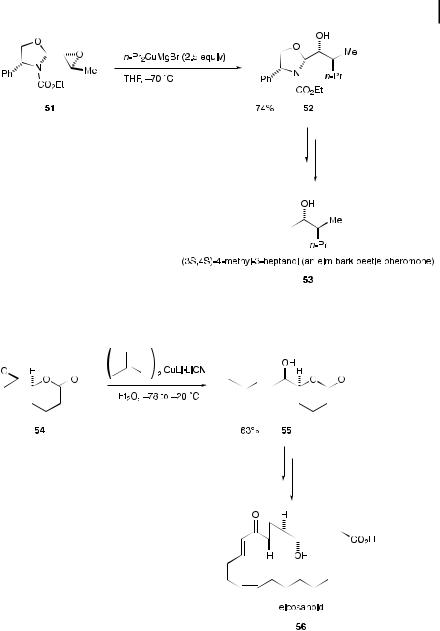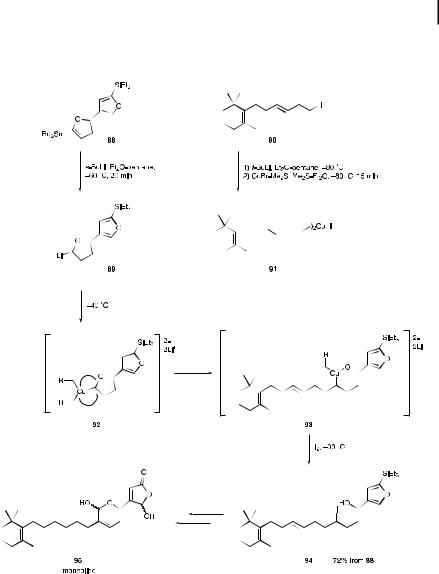
Modern Organocopper Chemistry
.pdf
298 9 Copper-Mediated Synthesis of Natural and Unnatural Products
ophile. On the other hand, treatment of vinyl triflate 41 with 1.5 equiv. of t-BuCu(CN)Li [36] in ether at 78 C for 1 h produced the desired ester 42 in 68% yield (Scheme 9.9). Coupling of 41 with the lower order cyclopropyl cyanocuprate reagent at 78 C for 1.5 h also a orded 44, in 71% yield. The double bond geometry was maintained during all these cuprate coupling reactions, and none of the undesired but more stable trans isomers of 42 and 44 were isolated.
Scheme 9.9.
In a total synthesis of cdc25A protein phosphatase inhibitor dysidiolide (46) [37], substitution on an sp3 carbon center by vinyl cuprate was used to accom-

9.2 SN2 Substitution 299
plish elaboration of the side chain (Scheme 9.10) [38]. The C-1 side chain was set in place by means of iodide displacement with the vinyl cuprate derived from 2-lithiopropene (10 equiv. of 2-bromopropene, 21 equiv. of t-BuLi, 5 equiv. of CuI, Et2O, 30 to 0 C, then 0 C for 30 min) to a ord 48 in 97% yield.
Scheme 9.10.
Several groups have recently accomplished various intramolecular and intermolecular Stille-type reactions [39] with the aid of a copper(I) salt in the absence of palladium catalysts, with transmetalation of organostannanes with the copper(I) salt serving to generate organocopper(I) species [40]. To explore the cephalosporin analogues as b-lactam antibiotics possessing high antibacterial activity, a non-palladium Stille-type reaction was used in the synthesis of C(3)-substituted D3- cephems [41]. Treatment of the 3-halomethyl-D3-cephems 49 with tributylvinyltin (1.5 equiv.) and copper chloride (1.0 equiv.) in the presence of terpyridine (1.0 equiv., added for coordinative stabilization of the generated vinylcopper species) in N-methyl-2-pyrrolidinone at room temperature predominantly a orded the 3- allyl-D3-cephem 50 in 68% yield (Scheme 9.11). Copper-promoted reactions with allenyltributyltin, allyltributyltin, and styryltributyltin were also successfully applied to the synthesis of cephem derivatives, giving the desired coupling products in 84%, 61%, and 50% yields, respectively.

300 9 Copper-Mediated Synthesis of Natural and Unnatural Products
Scheme 9.11.
SN2 Reactions with epoxides and aziridines are also synthetically useful. An example of epoxide cleavage with an organocopper reagent with sp3 carbon moieties is the enantioselective synthesis of (3S; 4S)-4-methyl-3-heptanol (53), an elm bark beetle (Scolytus multistriatus) pheromone [42]. The chiral epoxy oxazolidine 51 [43], prepared from (R)-phenylglycinol, reacted with a propylmagnesium bromidederived cuprate at 70 C to a ord the oxazolidine 52 in 74% yield (Scheme 9.12). Compound 52 was converted into the target molecular 53 by conventional procedures.
Epoxide ring-opening with transfer of an sp2 carbon moiety was applied in a short synthesis [44] of eicosanoid 56 [45], relevant in marine prostanoid biosynthesis (Scheme 9.13). Homoallyl alcohol 55 was obtained in good yield from 54 by use of a cyano-Gilman alkenylcuprate [46].
Cleavage of aziridines has been employed in the asymmetric total synthesis of pancratistatin 57 [47], a compound that is the object of considerable attention thanks to its broad spectrum of antineoplastic activities [48]. The chemistry of vinylaziridines has for the most part been confined to their use in rearrangement sequences resulting in functionalized pyrrolines. Hence, because of the lack of data concerning the ring-opening of vinylaziridines with carbon nucleophiles,

9.2 SN2 Substitution 301
Scheme 9.12.
Scheme 9.13.
there was a need for a preliminary study of the opening of aziridines with di erent organometallic species. According to this, whereas lithium diphenylcyanocuprate only shows anti-SN2 substitution, organometallic reagents predominantly react by syn-SN20 substitution; no explanation for this divergent reactivity is given. Ortho-

302 9 Copper-Mediated Synthesis of Natural and Unnatural Products
lithiation [49] of a dimethylamide species 58, followed by cuprate formation according to Lipshutz et al. [50], provided the required cyano-Gilman reagent 59 (Scheme 9.14). The reaction between 59 and the activated aziridine 60 gave a 75% yield of the product 61. This is the first example of the preparation of cyano-Gilman cuprates by amide group-directed ortho-metalation.
Scheme 9.14.
9.3
SN20 Substitution [51]
Organocuprates react rapidly with allylic halides (or acetates), propargyl halides (or acetates), and vinyloxiranes, frequently with SN20 regioselectivity. The reaction ordinarily takes place with anti (with respect to the leaving group) stereochemistry.

9.3 SN2 0 Substitution 303
In an alternative synthesis of pancratistatin (57) by Trost et al. [52], (Scheme 9.15) addition of the Grignard reagent 63 [53] to a mixture of the azide 62 and copper cyanide reproducibly gave the desired adduct 64. Because of the di culties associated with purification of adduct, the overall yield of the two steps (the next being dihydroxylation of the olefin) was 62%.
Scheme 9.15.
When an allylic carbamate is employed as a substrate, on the other hand, syn substitution occurs [54]. For example, two e cient synthetic routes to 1a,25- dihydroxy-16-ene-vitamin D3 (65) and its analogues have been developed (Scheme 9.16) [55]. In route A, the CD side chain fragments 67 and 69 were prepared by SN20 syn substitution of allylic carbamates 66 and 68 with R5Cu3Li2, and the triene unit was then constructed by coupling with the A ring fragment. In route B, SN20 syn allylation of the carbamate moiety took place on the intermediates 70 and 72, already possessing the vitamin D triene unit, to a ord the precursors 71 and 73. Both routes gave the desired allyl products in high yields.
In syntheses of the potent tetrapeptide mimetic farnesyl transferase inhibitors B956 (80) and B957 (81), the double bond pairs were constructed by application of iterative Nozaki–Hiyama–Kishi (NHK) and cuprate SN20 reactions (Scheme 9.17) [56]. The preparation of the precursor 75 for the Ibuka–Yamamoto SN20 replacement reaction [57] was carried out starting from 74, by means of the already mentioned NHK reaction [58]. The construction of the olefinic moiety of the peptide isostere 76 was e ected by copper-mediated displacement with alkyl nucleophiles. In practice, anti-SN20 diastereoselectivity with high E olefin selectivity was observed for the first iteration, on treatment of 75 with the reagent produced by addition of BF3 Et2O to a mixture of i-PrMgCl and CuCN. In the second iteration, the unusual Z olefin 78 – not the E olefinic product 79 expected from the normal anti pathway
– was obtained as the major isomer from the SN20 reaction of 77, again prepared through an NHK sequence. Compounds B956 and B957 were prepared in high yields from 78 and 79 by the usual sequence, both with >95% purity. This iterative NHK reaction followed by SN20 substitution thus demonstrates the widespread utility of organocopper reagents in the preparation of olefinic peptide mimetics of other interesting peptides.

304 9 Copper-Mediated Synthesis of Natural and Unnatural Products
Scheme 9.16.

9.3 SN2 0 Substitution 305
Scheme 9.17.
The propargyl structure of PDE IV inhibitor SB 222618 (82) was prepared with the aid of a regioselective SN20 substitution of the allenic compound 83 (Scheme 9.18) [59]. The most critical step in the synthesis of 82 is the preparation of the intermediate 85. Aryl copper reagent 84 was prepared as the substitution partner, since it is known that Vermeer-type organocopper species [60] of formula RCuMg2Br3 aLiBr exhibit good regioselectivity in SN20 reactions [61]. Treatment of 84 with the bromoallene 83 gave the desired propargyl product 85 in 60% yield.
Aziridine cleavage based on an SN20 reaction was used for the synthesis of peptides bearing E alkene dipeptide isosteres, a novel class of potent bombesin receptor antagonists [62]. Treatment of the vinylaziridine 86 (Scheme 9.19) with isobutyl and isopentyl magnesiocyanocuprates in THF at 78 C for 30 min. stereospecifically gave the desired E alkene isosteres 87 in high isolated yields [63].

306 9 Copper-Mediated Synthesis of Natural and Unnatural Products
Scheme 9.18.
Scheme 9.19.
9.4
1,2-Metalate Rearrangements
A 1,2-metalate rearrangement of a higher order cuprate, known as a Kocienski rearrangement [64], was used as a key step in the synthesis of the marine antiinflammatory sesterterpenoid manoalide 95 (Scheme 9.20) [65]. Treatment of the alkenyl lithium 89 (prepared from the alkenylstannane 88 with s-BuLi in a diethyl ether-pentane mixture) with the homocuprate 91 (produced from iodoalkane 90) gave the iodoalkene 94 in 72% overall yield from 88. The reaction proceeds as fol-

9.4 1,2-Metalate Rearrangements 307
lows. The cuprate reagent 92 is first formed from 89 and 91, and 1,2-metalate rearrangement then takes place as shown by the arrows in 92 to give 93. Iodonolysis of 93 results in 94.
Scheme 9.20.
The ‘‘western part’’ 97 of tylosin aglycon (96), a 16-membered macrolide, has also been synthesized using this Kocienski metalate rearrangement [66]. Treatment of the lithiated dihydrofuran 99 with the stannyl cuprate [67] obtained from Bu3SnLi and CuCN, followed by MeI alkylation, exclusively gave the E vinyl stannane 100, in 80% yield. In the last stage, stannyl cupration [68] of the deprotected enyne diol 101 a orded the desired (E; E ) stannyl diene 97 in 85% yield.
The advantage of this strategy is thus the subsequent trapping of the metalate rearrangement product to provide a clean, e cient, and highly stereoselective route to the trisubstitued alkenes.
